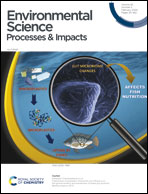Emerging investigator series: impacts of land use on dissolved organic matter quality in agricultural watersheds: a molecular perspective†
Abstract
In aquatic systems, dissolved organic matter (DOM) has important ecological and biogeochemical functions, where the molecular composition of DOM has larger-scale implications for climate change and global carbon cycles. However, there is limited information about the relationships between landscape characteristics and human disturbance that influence the molecular composition of DOM changes in watersheds. In this study, we collected water samples from 22 sites across a gradient of topographically characterized agricultural land coverage and community infrastructure development in the Kawartha region in Ontario, Canada. We employed a combination of Fourier Transform Ion-Cyclotron Resonance Mass Spectrometry (FT-ICR-MS) and absorbance spectroscopy to investigate changes in the molecular composition of DOM with increasing agricultural and community development disturbance on the optical and molecular characteristics of DOM. We found that dissolved organic carbon (DOC) concentrations in disturbed (>75%) watersheds ranged from 3.67–32.8 mg L−1 and were significantly higher than in watersheds with more abundant forest coverage (3.78–9.13 mg L−1). In addition, watersheds with higher phosphorus concentrations had more negative nominal oxygenation state of carbon (NOSC) values, suggesting biologically processed DOM correlating with increased phosphorus levels in aquatic systems. To relate the molecular properties of DOM to landscape metrics, we used Spearman's correlation analysis to reveal that agriculturally impacted and community developments enhanced the molecular signature of unsaturated hydrocarbon. In addition, we identified 65 dissolved organic phosphorus (DOP) molecules that significantly increased in abundance with disturbance, likely due to microbial mineralization of existing DOM with the addition of phosphorus to form larger, biologically inaccessible molecules. The overall recalcitrance of the identified molecules can serve as molecular signatures when evaluating the level of disturbance of a watershed.

- This article is part of the themed collections: Geochemistry, Emerging Investigator Series and Outstanding Papers 2024 – Environmental Science: Processes & Impacts


 Please wait while we load your content...
Please wait while we load your content...